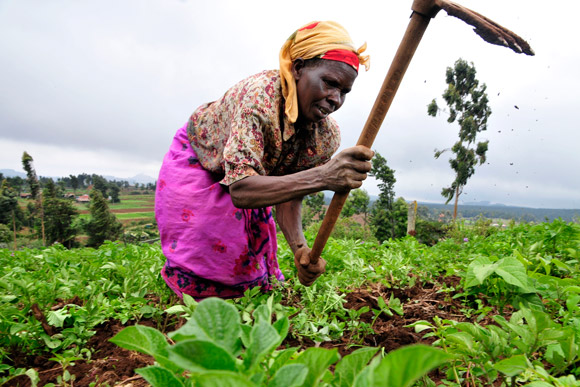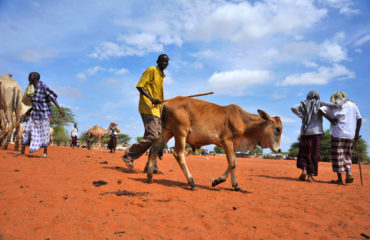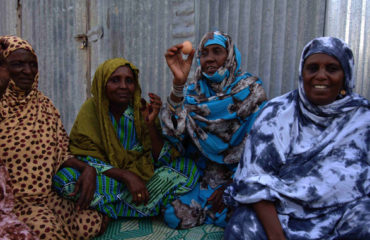Introduction
Of the 160 million people living in the Horn of Africa, 70 million live in areas prone to extreme food shortages. 60% of the land is home to 22 million pastoralists. More than 40% of the population in the region is undernourished due to food insecurity and inadequate livelihoods. During the 2010-2011 droughts malnutrition was as high as 30%.
Over the past 30 years, frequent famine – every five to seven years – and frequent conflicts have made this region one of the most food-insecure in the world. Urban poverty was the third greatest contributor to food insecurity in the region. Livelihoods and food security, therefore, are priority aspects of peace and development in this region. This has been difficult to achieve because of natural and man-made disasters including, human migration and conflict.
Fragility and Conflict context
The Horn of Africa has a long history of conflicts at the local community level and across borders between communities of different countries. Conflicts disrupt households and their support networks in livelihoods, community social life, food and livestock production, human movement, and commerce; leading to displacement of populations raising vulnerability factors at households adding to exposure to more risks.
The context of conflict has taken different dimensions in the Horn region in the last ten years. Apart from internal conflict, piracy, terrorism and political violence have brought new facets to conflict. In addition, the migratory lifestyle of pastoralists has been under threat and instability caused by conflict, change in governance and administration systems, climate change, environmental degradation and natural disasters.
Conflict and instability can severely affect socio-cultural, political and power relations. Conflict exacerbates the vulnerability of poor people, displacing them from their homes and depleting their assets. It makes emergency relief operations directed towards IDPs or refugees difficult and dangerous for those involved and has a much more negative impact on long-term development, diverting scarce resources away from development objective into war.
Human Migration
In this article, human migration is taken to mean the movement of human populations to settle in other geographic locations, due to any other cause other than intended and voluntary movement. In this regard, movement associated with disaster, conflict, or forced migration will be perceived to constitute human migration. Nomadic movement of communities will not be regarded as part of human migration as it does not in itself constitute an intention for settling. However, where some factors or forces associated with nomadic lifestyles enforce desire to flee or settle away from particular locations to avoid conflict, or attain safety; such migration will be categorized as part of trans-human movement and will be part of human migration.
Effects on livelihoods and food security
Conflict and human migration within the Horn of Africa brings with it a myriad of consequences for communities. The key consequences include:
- Increased causes of food insecurity for migrant groups, host communities and informal urban households
- Increase in new types of vulnerabilities, disadvantage and risks
- Reduced coping mechanisms among migrants and host communities
- Inadequate living conditions as relates to incomes; access to services and opportunities
- Low human and land productivity for lack of productive know-how, inputs and tools
- Increased pressure on local resources – land and spaces for shelter, basic services, shared resources, such as water, sanitation, schools, health services and sources of food.
- Opportunities for employment, whether formal or informal, are stressed with increased competition.
- Over-reliance on humanitarian support – Communities like pastoralists, fisher folk and informal urban households are forced to turn and be depended on humanitarian relief
- Barriers of access to land and water, e.g. land allocated to IDPs and refugees aare often not the best for production.
- Denied opportunities for production or work – local authorities impose barriers such as forms and levels of taxation, determining types of business or locations where IDPs and refugees can conduct their business.
- Resistance by host communities – host communities perceive unfair competition or lack of sufficient market for produce due to competition from refugees and IDPs
- Strained relations and transactions between migrants and host communities; or local authorities and informal land settlements
Conflict and Human migration cause food insecurity and, periodically, famine to the lives of a large proportion of the population of the Horn of Africa. Instability makes life intrinsically difficult with a shrinking and degraded resource base. Combined with population pressures, climate change and limited coping capacities, human lives are threatened. These challenges notwithstanding, resources like water and land continue to offer opportunities if utilized better in the region.
Climate-linked Risk Disasters
The Horn of Africa may not be big a contributor to climate-related factors such as carbon and other polluters. However, climate change is affecting the region drastically. Significant effects have been mainly seen from the perspective of flooding, landslides, and drought due to weather variability. The impact of these natural catastrophes has been reduced food production, especially among agro-communities. On the climate change, has led to many pastoralists losing large stock in livestock to the extent that they cannot recover fully to continue in pastoral livelihood lifestyles.
When flooding occurs, fisher-folk have short periods of boon but this quickly fades as waters rescind and dry out except where such communities of fisher folks are near a water mass or wetlands. Evidence has pointed out to some traditional fishing grounds in water masses and wetlands as showing signs of shrinking or having been interfered with by invasive plants like hyacinth and this threatens food security for fisher-folk.
As a result, pastoralists who exit their pastoral lifestyle have a challenging time adjusting to new ways of living. The most affected among them are young people, both male and female as they cannot carry out certain practices associated with being pastoralists as their ancestry dictates. This places households falling out of pastoralism in vulnerable conditions in that they have no recourse even with social and communal support. Without support, they are food insecure and risk falling deeper into poverty and disadvantage.
Conclusion
It is clear that the problem of livelihoods and food insecurity is complex and multifaceted one in which investments are needed focusing know-how for developing systems, education, health, energy and infrastructure to provide the framework that allows people to broaden livelihoods options that create long-term food security opportunities.





